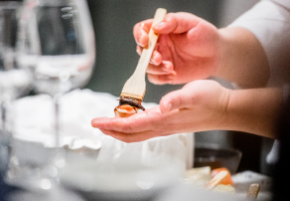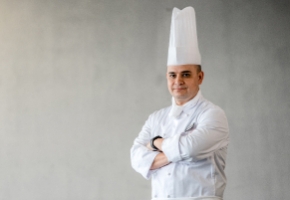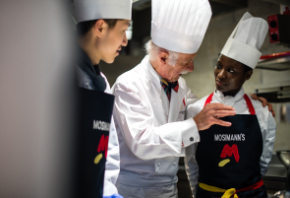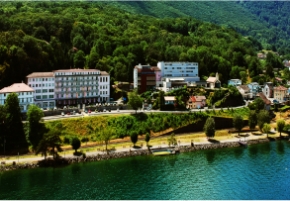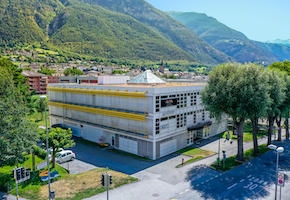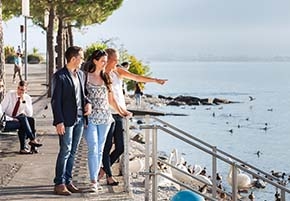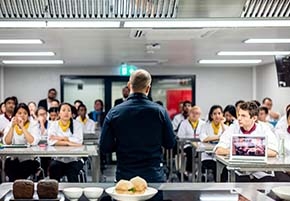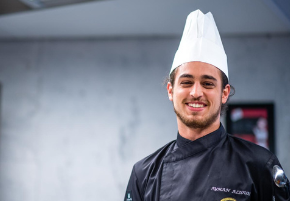- About
- Programs
- Campus Life
- Career Services
- Admissions
- News & Events
- Alumni
Oktoberfest Germany: Bavarian Foods, Beers, and Culture
Plan your trip to Oktoberfest Germany. Explore dates, Munich location, traditional foods, beers, and travel tips for an unforgettable experience.
Key Takeaways
- Oktoberfest takes place from late September through the first week of October in Munich's Theresienwiese.
- For hospitality and culinary professionals, Oktoberfest represents a masterclass in large-scale event management.
- Traditional Bavarian cuisine includes Schweinshaxe, Hendl, and authentic pretzels served alongside festival beers.
- Only six Munich breweries can serve beer, following strict brewing regulations established in 1516.
Germany is often praised for its discipline, precision, and strong work ethic. These are qualities that sometimes feed into the stereotype of being a little too serious to let loose. But once a year, that image gives way to something entirely different.
During Oktoberfest, Germany shows a side of itself that's vibrant, joyful, and entirely dedicated to community and fun. Amid the lively traditions and festivities, there's plenty to discover about what makes Oktoberfest special and how you can be prepared to enjoy it fully.
What Makes Oktoberfest Unique?
The first Oktoberfest was held in 1810 as a royal wedding celebration for Crown Prince Ludwig and Princess Therese. What started as a local festivity has since grown into the world's most famous beer and cultural festival, attracting millions of people to Munich each year.
Its authenticity primarily lies in tradition. Only beer brewed within Munich's city limits can be served, keeping the connection to Bavarian brewing practices alive since the Reinheitsgebot, the German Beer Purity Law of 1516. Through the beer, visitors can experience a heritage that's been carefully preserved for centuries.
The festival is also defined by Gemütlichkeit, a Bavarian term that captures warmth and friendliness. It's this atmosphere that makes Oktoberfest what it is. Guests from around the world come to enjoy the drinks, hearty Bavarian food, lively music, and a sense of community that breaks down barriers between strangers.
The scale itself is remarkable. In 2024, Oktoberfest hosted 6.7 million guests who consumed about 7 million liters of beer, served across 14 large tents and numerous smaller venues, some of which can hold nearly 10,000 guests at a time. Despite these massive numbers, the service remains distinctly Bavarian, balancing efficiency with hospitality.
For hospitality professionals and culinary enthusiasts, Oktoberfest represents a masterclass in large-scale event management, food service operations, and cultural preservation. The festival shows how centuries-old brewing traditions, regional cuisine, and modern guest experiences can be coordinated to create a cultural event that attracts millions yet still feels rooted in Bavarian identity.
This balance between heritage and global appeal reflects lessons emphasized at Culinary Arts Academy, where students study how culinary traditions can be preserved while meeting the expectations of contemporary international audiences. Just as Oktoberfest has grown into a global destination without losing its character, our academy teaches future chefs to connect cultural depth with modern practices.
Oktoberfest Germany Dates and Location
Oktoberfest takes place from the second or last Saturday in September at noon to the first Sunday of October, holding true to the tradition of sixteen lively days that stretch across multiple weekends. The festival unfolds at Theresienwiese, Munich's vast 42 hectares (approximately 104 acres) fairground that each year transforms into a temporary city filled with beer tents, restaurants, parades, and Bavarian cultural showcases.
The opening day is a highlight in itself. At noon in September, Munich's mayor ceremonially taps the first keg with the famous declaration "O'zapft is!" ("It's tapped!"), officially starting the celebrations. This moment is preceded by the colorful parade of the tent landlords, where brewers and innkeepers make their way through the city in horse-drawn carriages, accompanied by music and traditional dress, setting the tone for the weeks ahead.
As the only authentic Oktoberfest location in the world, Munich carefully protects the festival's character and oversees visitor capacity to ensure both safety and customer experience quality.
Accessibility is also part of its success: the festival grounds are directly connected to Munich's U-Bahn via lines U4 and U5 (Theresienwiese station), with additional S-Bahn links. The central location makes it convenient to reach from Munich's international airport and main train station, reinforcing the city's reputation as a premier European hospitality destination.
For orientation, visitors can consult the official festival grounds map, which shows the layout of tents, rides, and major attractions.
What Awaits You at Oktoberfest
The obvious answer is beer. Plenty of it. However, Oktoberfest is just as engaging for those who come for culture rather than beer.
The celebration comes alive inside vast beer halls and lively tents. Within these spaces, visitors encounter a distinctive mix of traditional brass bands setting the rhythm, Bavarian dishes served in generous portions, tent designs that reflect the character of each brewery, people dressed in traditional clothing, and even various fairground attractions.
Start Your Culinary Journey
Learn the art of cooking in a world-class environment
Music and entertainment
Traditional Bavarian brass bands perform continuously throughout the festival. These musicians, trained in centuries-old folk music traditions, lead crowds in classic songs like "Ein Prosit der Gemütlichkeit" while adapting their performances to match the energy levels throughout each day.
The musical programming follows a carefully orchestrated schedule that generally begins with traditional folk music during daytime family hours and gradually incorporates more contemporary German songs as evening celebrations intensify. Professional musicians rotate between tents, ensuring a consistent level of entertainment quality while providing authentic cultural education through music.
The Oide Wiesn (Old Oktoberfest) section specifically preserves historical entertainment traditions, featuring period-appropriate performances, traditional dance demonstrations, and authentic folk music that showcases Bavaria's cultural heritage for visitors interested in deeper cultural immersion.
Costumes and outfits
Authentic Bavarian traditional clothing, known as Tracht, is a significant reason why the festival feels so genuine to Bavarian traditions. Many visitors invest in quality dirndls (for women) and lederhosen (for men) to fully participate in the cultural celebration. These garments represent centuries of Bavarian craftsmanship and cultural heritage, with distinct regional variations that reflect the diverse areas of Bavaria.
The dirndl's apron bow placement carries traditional significance: tied on the left indicates the wearer is single, on the right signifies marriage or a relationship, centered at the front suggests virginity, and tied at the back indicates widowhood. Understanding these cultural nuances enhances visitors' appreciation for the depth of Bavarian traditions.
High-quality Tracht can be purchased from specialized Bavarian clothing stores in Munich or rented from numerous vendors near the festival grounds. Authentic pieces feature handcrafted details, natural materials such as wool and leather, and traditional construction methods that distinguish them from costume-quality alternatives marketed to tourists.
Traditional foods
The cuisine in Oktoberfest represents authentic Bavarian regional specialties prepared using traditional methods and locally sourced ingredients from Bavarian farms and suppliers. The festival's food standards maintain the same authenticity requirements as the beer selection, so that visitors can experience genuine regional cuisine rather than generic festival fare.
Schweinshaxe (roasted pork knuckle) is one of the festival's signature dishes, featuring massive portions of slow-roasted pork served with traditional sauerkraut and mustard. Hendl (roast chicken) provides a lighter alternative prepared using traditional rotisserie methods, while Steckerlfisch (grilled fish on a stick) offers fresh catches from Bavarian lakes and rivers prepared over open flames. These proteins pair with giant Brezn (soft pretzels), Weisswurst (white sausage), and Obatzda (spiced cheese-butter spread) to create the full Bavarian meal experience.
Of course, there are also sweet treats like Lebkuchenherzen (decorated gingerbread hearts with romantic messages) and Kaiserschmarrn (shredded fluffy pancake with raisins, powdered sugar and served with plum or apple compote), that showcase the region's baking expertise and cultural sweetness traditions.
Beers and drinks
Oktoberfest beer is brewed according to strict regulations that preserve the festival's authenticity. The Reinheitsgebot brewing standards guarantee that all festival beers contain only water, hops, malt, and yeast, eliminating artificial additives and preservatives while maintaining brewing traditions that date back over 500 years.
Only Munich's six traditional breweries—Augustiner, Hofbräu, Löwenbräu, Spaten, Hacker-Pschorr, and Paulaner—are permitted to serve it. Each produces the signature Märzen style, known for its amber hue, slightly stronger alcohol content of around 5.8–6.3%, and a malty depth of flavor that comes from slow, traditional brewing methods.
Every serving arrives in a one-liter Maßkrug, a hefty glass stein that is a tradition in itself. Handling it takes practice: the weight makes balance essential, and the thick glass helps keep the beer cool and carbonated. Servers are trained to move confidently through crowded tents, often carrying several steins at once, a skill that showcases both their strength and the professionalism behind Oktoberfest's hospitality.
There are also many options for other popular drinks too. Non-alcoholic ones include Spezi (cola-orange mixture), Apfelschorle (apple juice with sparkling water), and alcohol-free beer varieties that maintain traditional brewing quality. These alternatives guarantee inclusive hospitality that welcomes all guests regardless of alcohol preferences.
Events and culture
The festival begins each year with the traditional Einzug der Oktoberfest-Wirte und Brauereien (Entry of the Oktoberfest Landlords and Breweries), a grand parade featuring decorated horse-drawn wagons, traditional costumes, and brass bands that showcase Bavarian cultural pride. This ceremony exemplifies the community cooperation necessary to plan and execute large-scale cultural events while preserving authentic traditions.
Family-friendly programming includes designated "Family Days" with special entertainment designed for children, ensuring the festival maintains its role as a community celebration rather than exclusively adult entertainment.
Tent etiquette follows specific Bavarian customs, including toasting neighbors before drinking, standing on benches (never tables) during musical celebrations, and showing appreciation to servers through appropriate tipping. Understanding these customs helps visitors participate respectfully while supporting the service professionals who maintain the festival's high hospitality standards.
The festival concludes each year with the traditional Böllerschießen (cannon salute) and final ceremonial beer tapping, marking the end of the celebration while preserving the ceremonial traditions that connect contemporary festivities to historical customs.
Rides and fairground fun
In addition to its reputation as a beer festival, Oktoberfest also operates one of Europe's largest traveling funfairs, featuring over 80 rides and attractions that range from traditional carousel installations to modern roller coasters and thrill rides.
The classic Riesenrad (Ferris wheel) provides panoramic views of Munich and the festival grounds, while historical carousel installations showcase traditional German craftsmanship and artistry. These attractions preserve carnival traditions while also providing photography opportunities and cultural education about German engineering and artistic heritage.
Modern thrill rides include high-speed roller coasters and spinning attractions that meet contemporary safety standards while providing excitement for adventure-seeking visitors. The fairground section operates independently from the beer tents, allowing non-drinking visitors and families to enjoy festival entertainment without an alcohol focus.
The Oide Wiesn area specifically features historically accurate rides and attractions that recreate the festival atmosphere from earlier decades.
This blend of nostalgic carousels, family-friendly rides, and adrenaline-packed roller coasters means the fairground also appeals to children, families, and thrill-seekers, turning Oktoberfest into an inclusive celebration that attracts people of all ages and interests.
Travel Tips for Oktoberfest Visitors
The scale of the festival makes travel both more challenging and more convenient since hotels sell out months ahead, but the city is also exceptionally prepared for the crowds, with transportation and services designed to handle the influx.
To help make the most of your trip, consider the following travel tips for Oktoberfest visitors:
- Book early: Secure accommodations and flights at least 6 to 8 months in advance, as Munich's hotel capacity fills completely during the festival, and prices rise sharply. Staying in nearby Bavarian towns with train connections or renting apartments outside the city center are reliable alternatives.
- Reserve beer tents in advance: Reservations open in January for the next year's festival, and popular tents often fill within hours. Without a reservation, weekday afternoons offer the best chance to enter, though waits are common at peak times.
- Use public transport: Munich's public transportation system expands during Oktoberfest, with extra trains, festival-specific schedules, and ticket packages through MVG that also cover city attractions.
- Plan your budget: Expect higher prices during the festival. Meals typically range from €12–25, and a liter of beer costs around €11–13. Most vendors accept only cash, so arrange currency exchange or banking access ahead of time.
- Stay safe and pace yourself: Drink water between beers, pace your consumption across the day, and keep an eye on personal belongings in crowded areas. Medical and security services are well-organized on-site, but responsible choices are what guarantee the best experience.
Why Oktoberfest Matters to Culinary and Cultural Heritage
Every culture needs ways to celebrate and preserve its traditions, and few have fun in such an effective way as Germany does through Oktoberfest. What began as a wedding celebration has evolved into a festival that proudly preserves Bavarian heritage while also sharing it with the world.
Oktoberfest sustains agricultural and artisanal practices, supporting regional farmers, brewers, and food producers who continue to work with methods passed down through generations. Far from being symbolic, this cultural preservation carries weight in the modern economy as the festival generates an estimated €1.25 billion for Munich and contributes up to 2% of the city's GDP (Gross Domestic Product).
The event also functions as a global ambassador for German culinary arts. It showcases traditional brewing, meat preparation, baking techniques, and many other food traditions that continue to influence international hospitality standards. Chefs, brewers, and event professionals travel to Munich to celebrate as well as observe and learn how centuries-old methods can operate on a modern global stage.
The festival's influence has reached far and wide. Versions of Oktoberfest now take place across the world, each drawing inspiration from the Munich original while providing platforms for German exports and raising awareness of Bavarian culture. In this way, Oktoberfest has become a cultural model that demonstrates how authenticity, tradition, and hospitality can be scaled globally.
For students of hospitality and culinary arts, understanding the importance of these values for guest experiences is critical to success. This connection is exactly what Culinary Arts Academy reflects in all programs.
The Bachelor of Arts in Culinary Arts, with its focus on practical expertise, the Master of Arts in Culinary Business Management that develops both creative and managerial abilities, and the Swiss Diploma in Culinary Arts with its tradition-grounded training, all emphasize the idea that cultural authenticity is not an addition to professional excellence but one of its foundations.
Experience the Heart of Bavaria
Oktoberfest is a festival where Bavarian culture is lived, through its cuisine, music, traditions, and of course, the joy of coming together. While it's an occasion for celebration, it's also a reminder of how food, drink, and hospitality carry culture across generations.
Whether you plan to attend this year or in the years ahead, understanding its history and what to expect will help you enjoy the festival more fully.
If this festival proves anything, it's that food and drink create lasting bonds. That is a lesson our students take with them into every kitchen. So, join one of our programs and discover how food can be both a profession and a universal language of connection.
Frequently Asked Questions
What to wear to Oktoberfest in Germany
Wearing traditional Bavarian clothing like dirndls or lederhosen is part of the fun and cultural experience at Oktoberfest, though many visitors also enjoy the festival in regular attire.
How much does it cost to go to Oktoberfest in Germany?
It's best to budget around €150-200 per day for accommodation, food, beer, and transportation. Costs vary significantly based on accommodation choices.
How long does Oktoberfest last in Germany?
Oktoberfest runs for 16 days from the end of September to the first week of October. It maintains the traditional duration that spans multiple weekends.
Interested in studying at CAAS? Download our brochure to learn about our programs!


